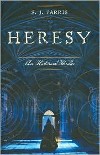| Another
Review at MyShelf.Com |
|
Heresy Doubleday First Sentence: The outer door was thrown open with a crash
that resounded along the passage, and the floorboards shook with
the purposeful marching of several pairs of feet. Philosopher and mathematician Giordano Bruno has come to Oxford, supposedly to debate on the theories of Copernicus. However, Sir Francis Walsingham, spymaster to Queen Elizabeth I, has sent him to seek out Catholics who seek to assassinate the Queen. He did not expect having to solve a series of murders where the victim has been styled to represent a Catholic martyr. For some reason, I had in my mind that this book would be slow and the plot would drag. Oh, was I wrong. From the opening paragraph, I was involved and wanted to know more. Parris writes with wonderful detail; I repeatedly thought that as I read. It was not that the detail distracted me, but it made the story richer. The sense of place detail is often thought of in broad, terms; here it was the small details of a room—I particularly loved the description of the bookbinder’s room—or setting; such as an almanac that contained both the prevalent calendar and the new Georgian calendar mandated by the Church for use in Catholic states, and of people. Then there was the historical detail. This was a time of great turmoil between Rome and Protestant England, where the books you read and/or the people with whom you associated could lead to expulsion from England or death. There are some very insightful statements made about religion and the divisions and hatred it can cause and the effect its power and instillation of fear has on people…”the way it makes men believe they alone are right.” The protagonist, Giordano Bruno, was a real, historical figure. Normally, I am strongly opposed against using either actual figures or iconic fictional characters created by others, as protagonists. I must confess, I was not familiar with Bruno so, in this case, it didn’t matter to me. However, in doing research on Bruno and in spite of there being references to actual events, the character still felt fictional; a good thing in this instance and he absolutely held his own in the story. The other most interesting character to me was Sophia Underhill, daughter of the rector. She was smart, gutsy and privileged beyond what was normal for women of the time, yet still subject to the prejudices and constraints of the time. She was very well written. Fortunately, the author did not attempt to write the dialogue in the vernacular of the period. Even though there may have been anachronisms, I did not notice any. I was too busy reading. Finally, we come to the plot and the overall quality of writing. The former I enjoyed. The story moved right along, there were no significant slow spots; it was certainly suspenseful and gripping. The quality of writing, however, suffered a bit. There were portents and way too many large coincidences, almost to the point where I started counting them. I very much enjoyed “Heresy,” but don’t know that I would read another book in the series. |
|
| Reviewer's Note: More S J Parris Novels | |
| Reviewed
2011 |
